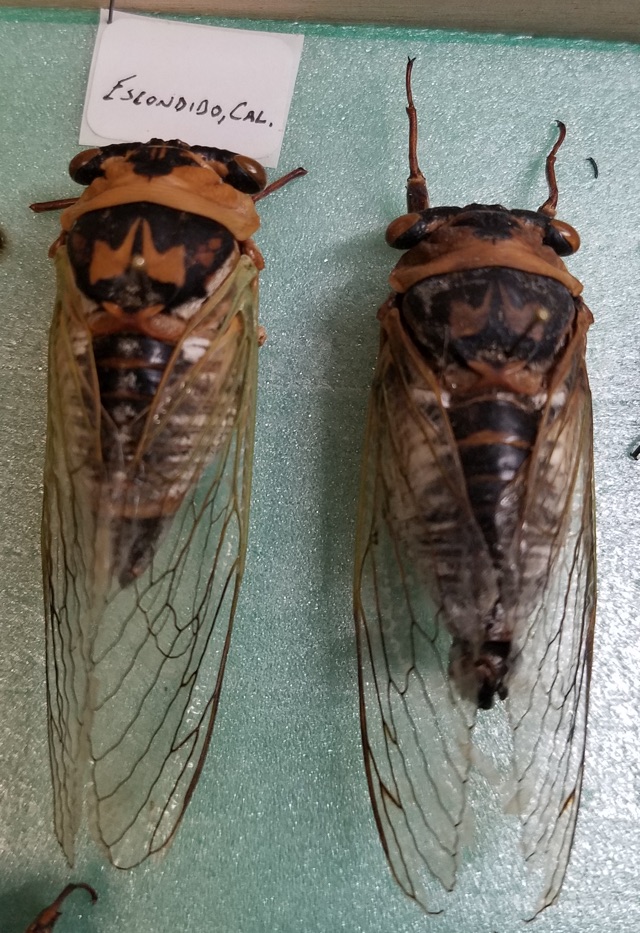Megatibicen cultriformis (Davis, 1915), aka the Grand Western Flood Plain Cicada, is large cicada found in the states Arizona and New Mexico in the U.S. and in Mexico. According to the Biogeography of the Cicadas (Hemiptera: Cicadidae) of North America, North of Mexico by Allen F. Sanborn and Polly K. Phillips, it is found in the Mexican Highland Section of the Basin and Range Province of the Sonoran Desert, and is associated with cottonwood and willow trees1.
Over the weekend, cicada collector Richard Newfrock emailed me some cicada photos for identification. Amongst those photos was what appears to be Megatibicen cultriformis labeled Escondido, Cal[iforia]. I asked Richard about the location, and sure enough, he said they were found in a pool in Escondido. I double-checked the species and location with top-tier cicada experts Jeffery Cole and David Marshall. From our conversation, I believe they agreed that the cicadas appeared to be M. cultriformis and that Escondido is far from its normal range (about 400 miles away).
Female (left), Male (right). Found floating in a pool.

So, how did these cicadas Megatibicen cultriformis end up in Escondido? More than likely, if they are truly M. cultriformis, they hitchhiked on a tree transported from Arizona to California — or as David Marshall said to me in an email, “it’s at least possible that cultriformis could have been introduced on the roots of saplings transplanted from Arizona”.
Does anyone in the Escondido area want to listen for these cicadas in the summer and report back to us if you hear them?
Listen to its song:
Source: ©Insect Singers
Scientific classification:
Family: Cicadidae
Subfamily: Cicadinae
Tribe: Cryptotympanini
SubTribe: Cryptotympanina
Genera: Megatibicen
Species: Megatibicen cultriformis (Davis, 1915)
William T Davis’s description from A New Cicada from Arizona2:
Resembles Cicada marginata Say [now called Megatibicen pronotalis walkeri Metcalf, 1955] in size, color, and markings. Head black with an oblong greenish yellow spot each side between the eyes and a small spot of the same color on the front just above the transverse rugae. Pronotum greenish yellow with a large, conspicuous black spot occupying the fore part of its central area. The hind margin of the pronotum (collar) is entirely unicolorous as in marginata. The mesonotum is black, with a pruinose band each side at the base of the wings; the elevated x is greenish yellow, and there are two conspicuous, irregularly formed (pipe-shaped) greenish yellow spots occupying its central portion. The tergum is black, each side broadly margined with pruinose, and the segments have their posterior margins yellowish. There is also an indication of a dorsal line of pruinose spots on the tergum, which in the type have been nearly worn off. Beneath the head is blackish, the remainder of the insect being greenish yellow and more or less pruinose. The costal margin of the fore wing is entirely greenish yellow, darkened beyond the middle, and the w-mark is inconspicuous. Both fore and hind wings are greenish-yellow at base, with the veins darkened beyond the middle.
Note that greens often fade to tannish colors after a cicada dies.
Trivia: In Latin, “cultr” means knife, and “form” means shape — cultriformis means knife-shaped. Davis named cultriformis because “uncus locks, which are s millimeters long in cultriformis, and when seen in profile are shaped like the blade of a pruning knife, hence the name.” The uncus is the male genitalia.
Resources:
- Location and habitat info: Biogeography of the Cicadas (Hemiptera: Cicadidae) of North America, North of Mexico by Allen F. Sanborn and Polly K. Phillips. Diversity 2013, 5, 166-239.
- A New Cicada from Arizona. Davis, William T. 1915. Journal of the New York Entomological Society. Vol 23. Pages 239-241.Read it on biodiversitylibrary.org.